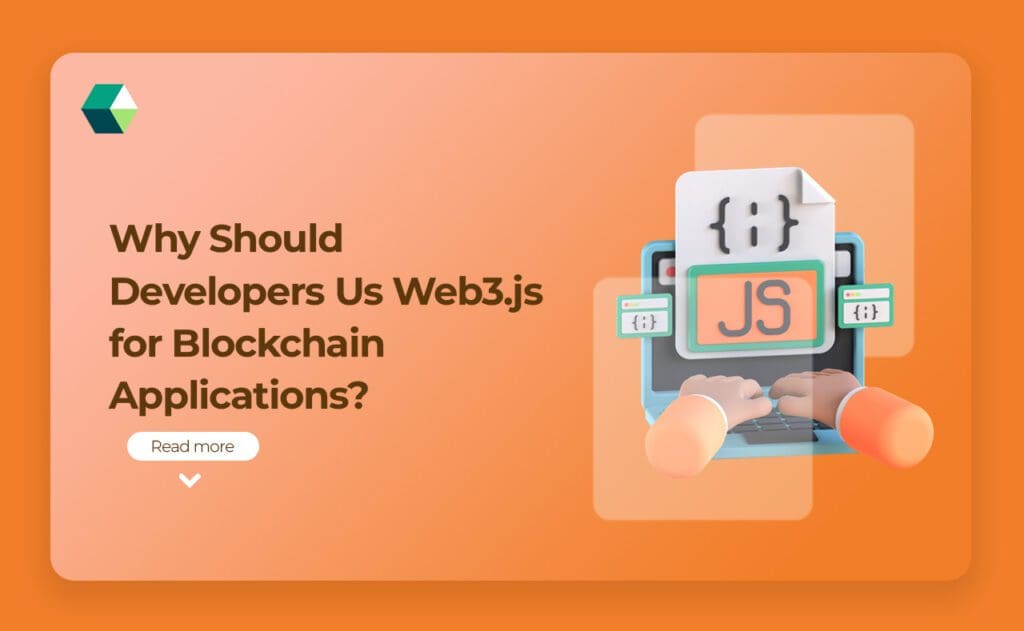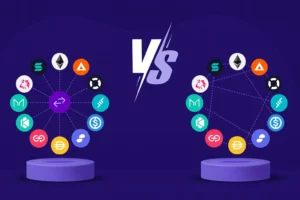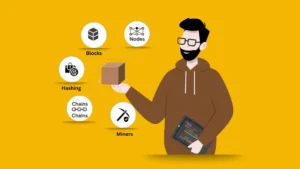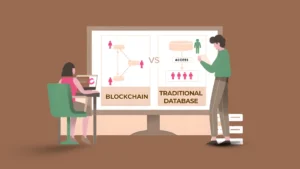
Developers are continually seeking tools that offer efficiency, reliability, and scalability. Among the many libraries available, Web3.js stands out as a powerful and essential tool for building blockchain applications. This blog delves into why Web3.js is the go-to library for developers, with a focus on its integration with various blockchain concepts like blocks, block data, and Bitcoin transactions.
What Is Web3.js and How Does It Work?
Web3.js is a powerful JavaScript library that enables developers to interact with the Ethereum blockchain and other Web3-compatible networks directly from a web browser or Node.js environment. It acts as a bridge between web applications and blockchain networks, facilitating communication and data exchange. Web3.js provides a comprehensive set of APIs to manage Ethereum accounts, send transactions, deploy smart contracts, and query blockchain data. It abstracts the complexities of blockchain interactions, allowing developers to write code in JavaScript to perform operations such as querying smart contract states, invoking contract methods, and listening for blockchain events. By connecting to Ethereum nodes via JSON-RPC, Web3.js enables seamless integration of blockchain functionalities into web applications, making it possible for users to interact with Decentralized Applications (DApps) and execute blockchain transactions directly from their browsers or server environments. Its robust features and ease of use have made Web3.js a fundamental tool in the development of modern decentralized applications.
What is Web3.js Used for?
Web3.js is used to facilitate interaction between web applications and the Ethereum blockchain, enabling developers to integrate blockchain functionalities into their applications. It serves as a bridge between the front-end of web applications and the Ethereum network, allowing developers to perform a range of blockchain-related tasks directly from their JavaScript code. With Web3.js, developers can manage Ethereum accounts, send transactions, deploy and interact with smart contracts, and retrieve blockchain data such as account balances and transaction history. Additionally, Web3.js supports event listening, enabling applications to react to changes on the blockchain, such as contract updates or transaction confirmations. This functionality is crucial for building decentralized applications (DApps) and integrating blockchain features into websites and mobile apps, providing users with a seamless experience in interacting with the blockchain ecosystem. Its versatility and ease of use make Web3.js an essential tool for developers working on Ethereum-based projects and other Web3 Consulting Company.
How to Get Started with Web3.js for Beginners?
-
-
Familiarize Yourself with Blockchain Basics
Before diving into Web3.js, it’s crucial to understand blockchain technology and Ethereum. Familiarize yourself with fundamental concepts like blocks, transactions, consensus mechanisms, and smart contracts. Resources such as online tutorials, courses, and documentation can provide a solid foundation. Ethereum is a decentralized platform that runs smart contracts and decentralized applications (DApps). Learn how Ethereum nodes work, what gas is, and how transactions are processed.
-
Set Up Your Development Environment
Web3.js is a JavaScript library designed to work with Node.js. Install Node.js from nodejs.org to get started. Node.js comes with npm (Node Package Manager), which is essential for managing JavaScript libraries and dependencies. An Integrated Development Environment (IDE) like Visual Studio Code, Sublime Text, or Atom is useful for writing and managing your code. Visual Studio Code is particularly popular for its extensive features and support for JavaScript development.
-
Initialize Your Project
Open your terminal or command prompt and create a new directory for your project. Navigate into this directory using the cd command. Run npm init to create a package.json file, which will manage your project’s dependencies and configurations. Follow the prompts to set up your project details.
-
Install Web3.js
Install the Web3.js library using npm by running npm install web3 in your project directory. This command adds Web3.js to your project’s dependencies.
-
Connect to an Ethereum Node
To interact with the Ethereum network, you need access to an Ethereum node. Services like Infura and Alchemy provide this access without the need to run your own node. Register on Infura or Alchemy, create a new project, and obtain an API key (endpoint URL) for connecting to the Ethereum network.
-
Write Your First Script
In your project directory, create a file named index.js or any name you prefer. Import Web3.js and connect to your Ethereum node using the API key you obtained.
-
const Web3 = require('web3');
const web3 = new Web3('https://mainnet.infura.io/v3/YOUR_INFURA_PROJECT_ID'); // Replace with your Infura or Alchemy URL
// Example: Fetch the latest block number
web3.eth.getBlockNumber()
.then(blockNumber => {
console.log('Latest Block Number:', blockNumber);
})
.catch(error => {
console.error('Error fetching block number:', error);
});
-
Interact with Ethereum
Use Web3.js functions to read data from the blockchain. For example, you can query an Ethereum address’s balance or retrieve information from smart contracts. Learn how to send transactions, which involves managing Ethereum accounts and handling private keys securely. Ensure you understand gas fees and transaction confirmation. Web3.js enables you to deploy smart contracts and interact with them. Learn how to deploy a smart contract using Web3.js and call its functions.
-
Experiment and Build Projects
Begin with small projects like building a basic DApp or creating a script to interact with existing smart contracts. This hands-on approach will deepen your understanding and skills. Utilize online tutorials and resources to explore more advanced features of Web3.js. Many platforms offer step-by-step guides for building DApps and integrating blockchain functionality.
-
Stay Informed
The Web3.js library and Ethereum ecosystem are rapidly evolving. Keep up with the latest updates by following the official Web3.js documentation, GitHub repository, and community forums. Engage with the Ethereum and Web3.js communities through forums, social media, and developer groups. Participating in discussions and events can provide valuable insights and support.
What Makes Web3.js a Great Tool for Blockchain Developers?
Web3.js stands out as an exceptional tool for blockchain developers due to its comprehensive and user-friendly approach to interacting with the Ethereum blockchain. It simplifies the complexities of blockchain integration by providing a robust JavaScript library that seamlessly connects web applications with Ethereum nodes. Web3.js offers a wide range of functionalities, including managing Ethereum accounts, sending transactions, and interacting with smart contracts, all through intuitive JavaScript APIs. Its support for event handling allows developers to create responsive applications that react to blockchain changes in real-time.
The library’s versatility extends to both front-end and server-side applications, making it suitable for various development environments. Additionally, Web3.js abstracts much of the low-level technical detail, enabling developers to focus on building features and functionality rather than dealing with the intricacies of blockchain communication. This ease of use, combined with extensive documentation and community support, makes Web3.js a powerful and essential tool for creating decentralized applications and integrating blockchain technology into modern web projects.
Web3.js Popular Among Web3 Developers
Web3.js has gained significant popularity among Web3 developers due to its essential role in bridging traditional web technologies with the Ethereum blockchain. Its user-friendly JavaScript API allows developers to interact seamlessly with Ethereum networks, manage smart contracts, and handle blockchain data directly from web applications. The library simplifies the process of integrating decentralized features into websites and applications, making blockchain technology accessible to developers who are already proficient in JavaScript.
Web3.js supports a broad range of functionalities, including sending transactions, querying blockchain states, and responding to real-time events, which are crucial for building interactive and dynamic Decentralized Applications (DApps). Additionally, it plays a significant role in implementing concepts like Token Curated Registry (TCR), enabling decentralized curation mechanisms for various applications. Its widespread adoption is also bolstered by extensive documentation, a vibrant developer community, and ongoing updates that keep it aligned with the latest advancements in the Ethereum ecosystem. This combination of ease of use, flexibility, and robust support has made Web3.js a go-to tool for developers looking to create and integrate blockchain solutions into their projects.
How to Optimize Performance with Web3.js?
Optimizing performance with Web3.js involves several strategies to ensure that your decentralized application (DApp) runs efficiently and effectively. Here are key approaches to optimize Web3.js performance:
-
Minimize Web3 Calls
Reduce the number of network calls by batching multiple requests into a single call. Web3.js allows you to batch requests using web3.eth.getBlockNumber() and other methods to decrease network overhead. Implement caching strategies to store frequently accessed data locally rather than fetching it from the blockchain repeatedly. This can include contract data, user balances, and other static information.
-
Efficient Use of Contracts
Ensure that your smart contracts are optimized for gas efficiency and performance. Write concise and efficient contract code to minimize transaction costs and execution times. For functions that do not modify the blockchain state, use call() instead of send() to avoid unnecessary gas costs and improve performance.
-
Manage Event Listeners Wisely
Implement throttling or debouncing techniques for event listeners to reduce the frequency of state updates and avoid overloading the UI or network. Use event filters to listen for specific events or transactions, minimizing the volume of data processed and improving responsiveness.
-
Optimize Transaction Management
Dynamically adjust gas prices based on network conditions to ensure that transactions are processed efficiently without unnecessary delays or failures. Implement a queuing system for transaction management to handle multiple transactions smoothly and avoid overloading the network.
-
Improve User Experience
Use loading indicators and progress bars to provide feedback to users while blockchain operations are being processed. This improves the perceived performance and usability of your DApp. Ensure that all blockchain interactions are handled asynchronously to avoid blocking the main thread and causing UI lag.
-
Leverage Web3 Provider Libraries
Utilize Web3 provider libraries like MetaMask or Infura to ensure efficient and reliable connectivity to the Ethereum network. These providers often offer optimized performance and additional features.
Why Choose Web3.js for Your Web3 Development?
Choosing Web3.js for your Web3 development is a strategic decision that offers numerous advantages for integrating blockchain technology into your applications. Web3.js stands out due to its comprehensive and user-friendly JavaScript API, which facilitates seamless interaction with the Ethereum Blockchain. It simplifies complex tasks such as managing Ethereum accounts, sending transactions, and interacting with smart contracts, allowing developers to leverage their existing JavaScript skills while building decentralized applications (DApps).
The library supports real-time event handling, making it easier to create responsive and dynamic applications that react to blockchain events and state changes. Its extensive documentation, active community, and regular updates ensure that developers have access to the latest features and best practices. Additionally, Web3.js is compatible with various Ethereum node providers and wallet services, enhancing its versatility and integration capabilities. By choosing Web3.js, developers benefit from a robust and well-supported tool that accelerates the development process and streamlines the integration of blockchain functionalities into modern web projects.
What Unique Web3.js Solutions Does Nadcab Labs Provide?
Nadcab Labs offers unique Web3.js solutions tailored to meet the diverse needs of blockchain developers and businesses. Their expertise extends beyond the basic integration of Web3.js, providing advanced solutions that optimize performance, enhance security, and streamline development processes. Nadcab Labs excels in customizing Web3.js implementations to fit specific project requirements, whether it’s for developing complex decentralized applications (DApps), integrating with various Ethereum node providers, or creating bespoke smart contract interactions. They also focus on optimizing Web3.js performance by implementing advanced caching strategies, managing gas fees efficiently, and ensuring smooth event handling.
Additionally, Nadcab Labs offers comprehensive support for integrating Web3.js with popular wallet services and DeFi protocols, providing a seamless user experience and robust functionality. Their commitment to leveraging the latest advancements in Web3.js and their deep understanding of blockchain technology make Nadcab Labs a go-to partner for delivering cutting-edge Web3 solutions that drive innovation and success in the decentralized space.






